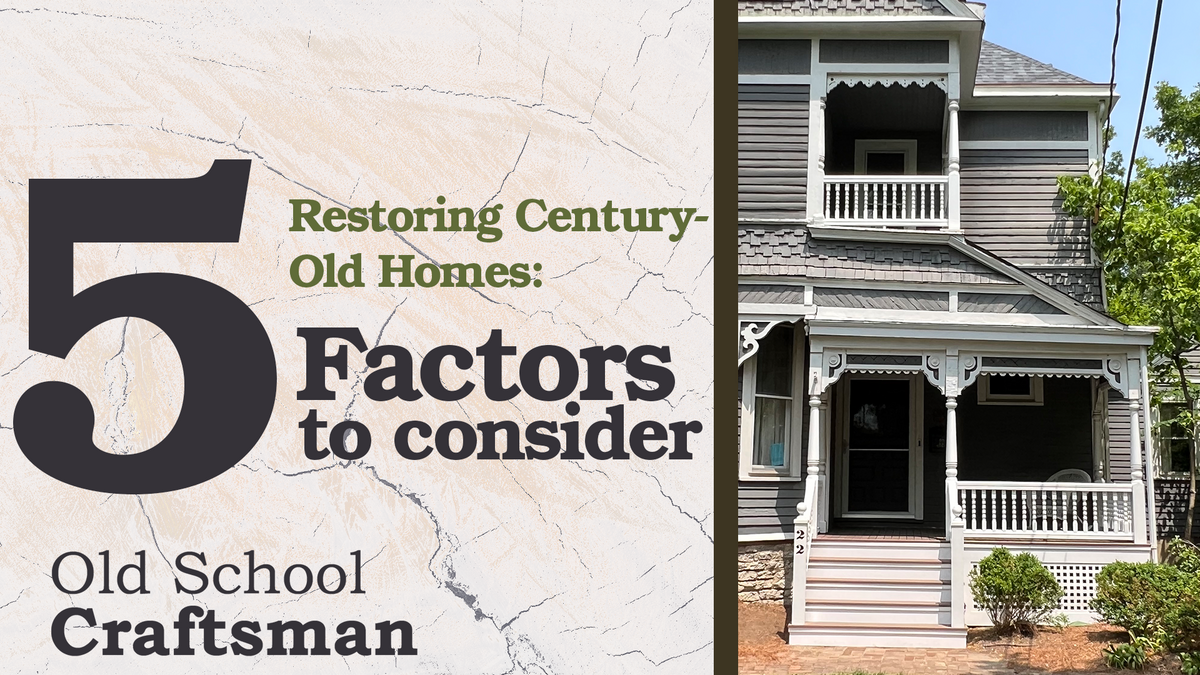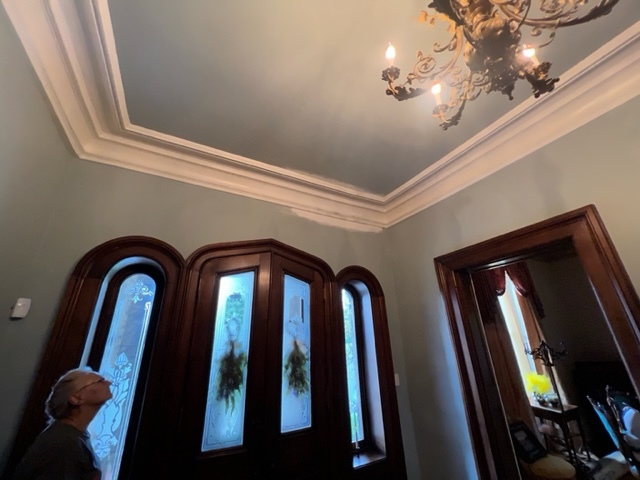Renovating Century-Old Home: 5 Factors to Consider

When looking back at home architecture over the last one hundred-plus years, there are few homes more beautiful than those built around the turn of the century.
These homes were built around 1900, a time fraught with conflict, innovation, and expanding industrialization. The availability of mass-produced home materials and recently built railroad lines meant that easily replicated styles became popular, contributing to designs that still hold great beauty today.
Some of the styles popular at the time included Victorian styles, massed plan vernacular, shingle style, American Colonial Revival, one-story bungalows, and American Foursquare. All these styles present fantastic visual appeal, but one-hundred-plus years after their construction, multiple areas are likely to need attention.
In this blog post, we will look at five considerations you should make when renovating a turn-of-the-century home so you can maintain the style and beauty of this era while fostering a modern and comfortable home.

Your Guide for Turn-of-the-Century Home Restoration
Assess The Situation Truthfully
Assessing the situation truthfully is a crucial step when renovating a turn-of-the-century home. The key areas that need to be evaluated include the foundation, electrical systems, plumbing, structural integrity, and overall maintenance needs.
Starting with the foundation, it is important to hire a professional to inspect it for any cracks, settling, or water damage. This will help determine if any repairs or reinforcements are necessary to ensure the stability of the home.
Next, the electrical systems should be thoroughly assessed. This includes checking the wiring, outlets, and panels for any outdated or faulty components. Upgrading the electrical systems may be required to meet modern safety standards and accommodate the electrical needs of a 21st-century household.
Similarly, the plumbing should be evaluated to identify any leaks, blockages, or outdated pipes that may need replacement. This is crucial to prevent any water damage and maintain a functional plumbing system.
Structural integrity should also be carefully examined. This involves checking the walls, ceilings, floors, and roof for any signs of damage, such as cracks, sagging, or leaks. Addressing any structural issues is essential to maintain the overall stability and safety of the home.
Finally, the overall maintenance needs of the home should be assessed. This includes evaluating the condition of windows, doors, HVAC systems, and other essential components. Additionally, considering any desired modern touches while preserving the historic character and original features of the home is important.
By assessing the situation truthfully and paying attention to these key areas, one can make informed decisions and create a renovation plan that meets the needs of the 21st century, while preserving the unique charm of a turn-of-the-century home.

Beware Water Damage
When renovating a turn-of-the-century home, one of the most important considerations is addressing water damage. Water infiltration can have long-term effects on the structure and stability of the house if not properly addressed.
One of the major risks associated with water damage is the development of dry rot. This occurs when moisture consistently infiltrates areas such as wood beams, joists, and subflooring. Over time, dry rot weakens the wood, compromising the structure's stability. Additionally, water damage can lead to bug infestations, as insects are attracted to damp areas.
The sill plate, the bottom horizontal member of the house frame, is vulnerable to water damage. When exposed to excessive moisture, the sill plate can deteriorate, affecting the entire structure's integrity. It is crucial to carefully inspect the sill plate and address any signs of water damage during the renovation process.
To identify areas with water damage, pay close attention to the ceilings, floors, and windows. Look out for water stains, discoloration, peeling paint or wallpaper, sagging ceilings, or soft or spongy flooring. These signs suggest water infiltration and should be addressed promptly to prevent further damage.

Start Small then Work Upwards
When renovating a turn-of-the-century home, it is crucial to start small and work upward. This approach is not only cost-effective but also allows for a systematic and manageable approach to uncover and resolve issues. By focusing on smaller projects initially, homeowners can address immediate concerns and lay a solid foundation for larger renovations down the line.
One area to consider when starting small is crown molding. Crown molding has a significant impact on the overall aesthetic appeal of a property. Also known as cornice molding, is a decorative trim installed along the top edge of interior walls where they meet the ceiling. By enhancing or replacing outdated or worn-out crown molding, homeowners can breathe new life into their spaces instantly add a touch of elegance, sophistication, and craftsmanship to any interior. It serves as a focal point that enhances the architectural features and character of a home, while also concealing imperfections and providing a seamless transition between walls and ceilings. Whether it's a vintage Victorian home or a contemporary space, improving crown molding offers a timeless and versatile upgrade that adds beauty and charm to any restoration project.
By tackling these smaller projects first, homeowners can better plan and prioritize larger renovations. This approach ensures that critical areas are addressed early on, reducing the risk of further damage and unexpected costs. It also allows for a step-by-step renovation process, ensuring that each project is completed successfully before moving on to the next one.

The Roof, Windows, and Masonry are Necessities
When embarking on a restoration project for a turn-of-the-century home, it is crucial to pay attention to key components such as the roof, windows, and masonry. These elements are not only essential for the structural integrity of the house but also play a significant role in preserving its historic character.
Windows, with their distinctive architectural details, are another crucial aspect to consider. Original windows are often made of solid wood, providing both aesthetic appeal and a connection to the home's history. Repairing or replacing damaged or inefficient windows is important, as it helps maintain the authenticity of the house while also improving energy efficiency and indoor comfort.
Masonry, including brickwork or stonework, is a defining feature of many turn-of-the-century homes. Proper maintenance and repairs are crucial for the property's aesthetic appeal and structural stability. Ignoring masonry issues can lead to further deterioration and potential safety hazards.
In renovating a historic home, it is vital to respect its unique character and preserve its heritage. By addressing the roof, windows, and masonry, homeowners can ensure the structural integrity of the house while simultaneously maintaining its original charm. These necessities serve as a strong foundation for a successful and authentic turn-of-the-century home renovation.

Embrace the Uniqueness of Your Home
When renovating a turn-of-the-century home, it's essential to embrace the uniqueness and historic charm that these properties possess. These homes often boast original features and architectural details that have stood the test of time. Preserving these elements not only adds to the property's appeal but also helps to maintain its historical significance.
One of the key aspects to consider when renovating is preserving the original features of the home. From intricate ceiling roses to elegant plaster walls, these unique aspects contribute to the overall character of the property. By carefully restoring and maintaining these features, you can enhance the charm and authenticity of your home.
Additionally, paying attention to the historical details of the property can significantly impact its overall appeal. From the type of windows and doors to the style of brickwork or stonework, these elements serve as reminders of the home's rich history. Embracing these details and incorporating them into your renovation can elevate the property's aesthetic appeal and create a seamless blend of old-world charm with modern living.
What do you need to consider when choosing a luxury home remodeling service? Read this blog post to learn more!
Old School Craftsman is Here for Your Home Restoration Project
Restoration projects for historic houses can be a challenge. Preserving the original details and original character of the home keeps the history of the community alive and gives you a home that has a unique style that is all too often lost in modern home construction.
Homes built around 1900 were the first built using mass-produced materials in the age of industrialization, and because of this, for the first time, popular styles were able to be replicated in areas all over the country.
These homes are beautiful, but they must be cared for properly. Not just anyone can perform refurbishments necessary to maintain or replicate the marvels of these aged homes. If you hire a contractor without experience working with older homes, then they might even do more harm than good.
Through our collaboration with the Wyoming Historical Society, Old School Craftsman ensures that the unique architectural legacy is safeguarded for future generations to appreciate and enjoy. Their shared commitment to historical preservation and passion for maintaining the authenticity of Wyoming's heritage make this partnership a powerful force in the ongoing efforts to honor and celebrate the town's rich history.
If you need an experienced craftsman who knows how to preserve the beauty of homes from the turn of the century and other eras, then Old School Craftsman is here for you! We have extensive experience refurbishing and remodeling antique homes and helping the original character of houses of all eras shine through.
We proudly serve Kenwood, Blue Ash, Mason, Hyde Park, Wyoming, Sycamore, Mt. Lookout, Anderson, Madeira, Indian Hill, Mariemont, Terrance Park, and more. Click here to start a conversation about your home renovation needs today!
Don’t miss the best! Follow Old School Craftsman on Facebook, Instagram, and Pinterest for more free home renovation tips!
Satisfied with the Old School Craftsman difference? Leave us a quick review on Google here!
